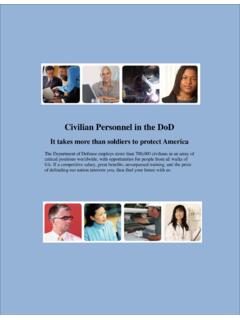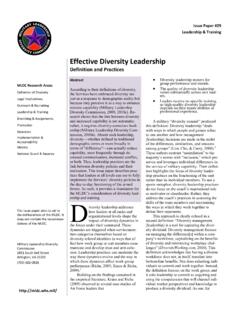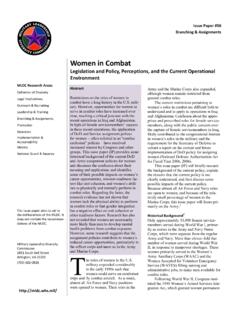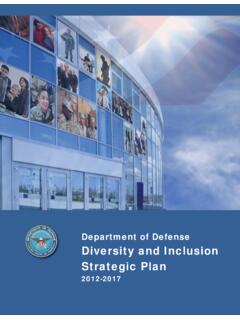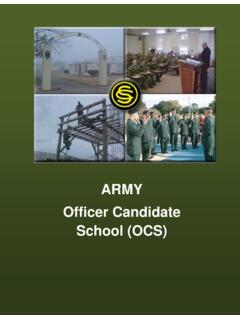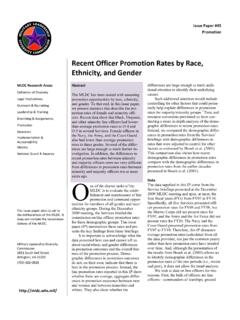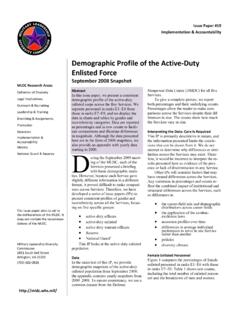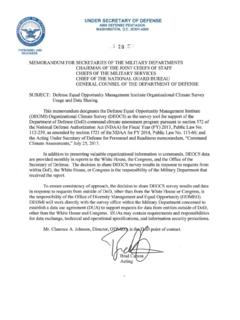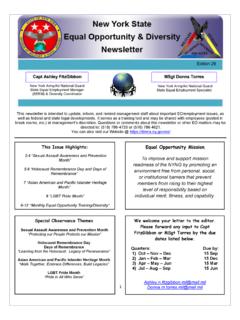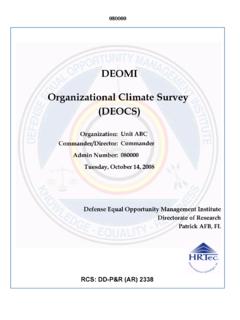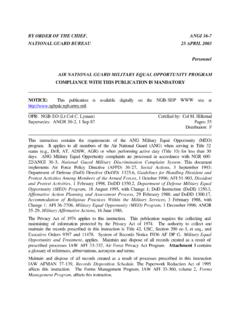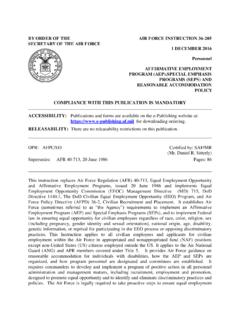Transcription of Measuring Service Climate with an Eye for Diversity
1 Issue Paper #42. Metrics Measuring Service Climate with an Eye for Diversity MLDC Research Areas Abstract policy and practice or highlight areas that re- quire further investigation. The Services em- Definition of Diversity Drawing on surveys administered by ploy a variety of surveys to examine numer- Legal Implications defense equal opportunity management ous facets of Climate . These facets can be Institute (DEOMI) and the Services as well grouped into three categories: general organ- Outreach & Recruiting as on outside literature on organizational izational Climate , equal opportunity (EO) cli- Leadership & Training Climate , this issue paper describes aspects of mate, and Diversity Climate .
2 Branching & Assignments Climate currently measured by the military, The MLDC charter tasks the commission methods of data analysis currently used by with examining existing metrics and identify- Promotion DEOMI, alternative measures used by pub- ing new metrics to facilitate the future evalua- Retention lic agencies, and key issues to consider tion and oversight of Department of defense when selecting Climate survey measures. (DoD) Diversity plans. To support this tasking, Implementation &. Our review indicates that many efforts to this issue paper describes Accountability understand various aspects of Climate are Metrics under way. Although the different surveys the facets of Climate that are cur- National Guard & Reserve explore some common topics ( , leader- rently measured ship, unit cohesion, attachment to the Ser- the content of some surveys currently vice), each of them measures the topics in used across the Services different ways.
3 In addition, DEOMI notes methods of analysis currently used that potentially helpful constructs, such as by the defense equal opportunity management Institute (DEOMI). leaders use of Diversity competencies, are not yet measured. Most importantly, some alternative measures used by public agencies research indicates that measures should be valid, reliable, and linked to the organiza- key issues to consider when selecting Climate survey measures. tional mission and goals. G. Facets of Climate Currently Measured iven demographic trends in the The three facets of Climate described in the United States, demographic This issue paper aims to aid in previous section are currently measured by Diversity in the military is likely the deliberations of the MLDC.
4 It the Services and have implications for the to increase over time. Prior does not contain the recommen- management of Diversity . Organizational research has found that a major organiza- dations of the MLDC. Climate refers to employees shared percep- tional problem with managing Diversity tions or experiences of the policies, practices, stems not so much from an inability to hire and procedures of their workplace and the as from the difficulties experienced in mak- behaviors that are expected, rewarded, and ing the best use of each employee s poten- supported. In the literature on industrial Military Leadership Diversity tial and in retaining and promoting talent organizational psychology, Climate questions Commission after initial recruitment (Thomas, 1990.)
5 Are usually framed in terms of what respon- 1851 South Bell Street Military Leadership Diversity Commission, dents perceive are the behaviors/actions that Arlington, VA 22202 2010). Research has also found that Climate leaders or managers take with respect to some (703) 602-0818 perceptions are associated with both indi- specific organizational goal. In this issue pa- vidual job performance (Pritchard & Kara- per, we use the term organizational Climate sick, 1973; Brown & Leigh, 1996) and more colloquially, so it encompasses such organizational performance (Lawler, Hall, concepts as morale, trust, leadership, and & Oldham, 1974). Surveys are often used to teamwork. Analyzing such data by demo- assess employees feelings, perceptions, and graphic group allows leadership to determine experiences, and findings can help inform whether certain demographic groups perceive and experience The table shows that some topics are of interest across the the organization and their individual job situations differently Services, such as leadership, unit cohesion, attachment to than others.
6 The Service , and the EO environment. However, each of Interest in Measuring EO Climate emerges directly from these surveys or interview protocols measures these topics in EO laws. A positive EO Climate describes an environment in different ways. We are clear to call these topics because, which people are not excluded based on such immutable traits except in the case of the DEOMI surveys, we were not pro- as race/ethnicity and gender and in which all receive equal vided information regarding whether the survey items under treatment and respect, ensuring that no discrimination or hos- these topics are merged into scales that are reliable and valid tile environment exist in the workplace.
7 Prior research has for analysis. Survey scales provide a quantitative measure- found that, among active-duty personnel, a positive EO ment of an abstract theoretical concept ( , leadership, unit Climate is associated with positive organizational commit- cohesion). ment, job satisfaction, and perceived work group effectiveness Constructs Measured Through DEOMI Surveys. (McIntyre, Bartle, Landis, & Dansby, 2002; Estrada, Stetz, DEOMI provided definitions of the constructs that it meas- & Harbke, 2007), whereas negative EO behaviors ( , racist ures through the DEOCS (Table 2) and the DDMCS (Table behaviors and sexual discrimination) are associated with 3). These serve as examples of how Diversity -related con- lower job satisfaction, organizational commitment, and work structs are defined and measured.
8 Group effectiveness (McIntyre et al., 2002). DEOMI Analysis of Survey Data. DEOMI supplied infor- Emerging from efforts to measure the EO Climate are mation on how data from the DEOCS are First, efforts to measure the Diversity Climate . Prior literature has analysts calculate the averages of each Climate factor for the identified two aspects of Diversity Climate : an individual unit and compare them with the overall average for the re- aspect, meaning individuals views and feelings toward spective Service and with the overall average for all Services people who are different from them, and an organizational combined. These averages are calculated using DEOCS data dimension, which encompasses leadership s policies and from the most-recent six months, which creates a contempo- procedures targeted toward women and minorities (Mor- rary comparison.)
9 Barak, Cherin, & Berkman, 1998). Diversity Climate often Finer-grained comparisons between complementary encompasses the concept of inclusion the degree to which groups of respondents across the 13 Climate factors are also an employee is accepted and treated as a full member of the provided in the DEOCS report. These comparisons are group by others in a work system (Pelled, Eisenhardt, & Xin, intended to highlight potential Climate problems that may 1999). exist among subgroups within an organization. Examples of such problems include women reporting lower trust in the Current Efforts to Measure Aspects of Climate organization than men, civilian members reporting lower job Surveys and Topics.
10 The military uses several surveys to satisfaction than their military counterparts, and enlisted assess various aspects of DEOMI administers two members reporting a higher likelihood of witnessing racial surveys for the Services: the DEOMI Organizational Climate discrimination than officers. Survey (DEOCS), which measures organizational Climate Table 4 provides an overview of these comparisons. dimensions that can affect organizational effectiveness, and To facilitate interpreting these subgroup comparisons, the the DEOMI Diversity management Climate Survey DEOCS uses a color coding scheme (green, yellow, orange, (DDMCS), which measures Climate factors associated with red) that, for each comparison between complementary Diversity and inclusion.
